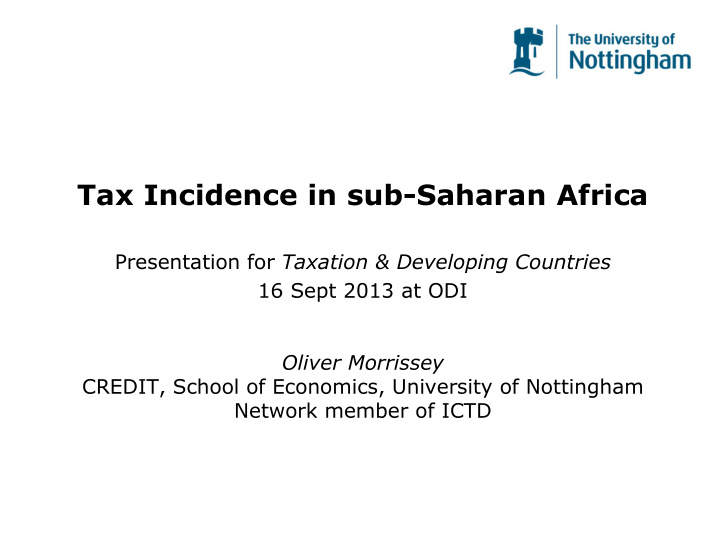



Tax Incidence in sub-Saharan Africa Presentation for Taxation & Developing Countries 16 Sept 2013 at ODI Oliver Morrissey CREDIT, School of Economics, University of Nottingham Network member of ICTD
Tax Incidence Outline • Incidence Concepts i) Economic Incidence ii) Distribution of Tax Burden • Evidence based on Indirect Taxes • (Scattered) Country evidence • Conclusions: Who Bears Tax Burdens?
Tax Incidence Economic Incidence • Who is expected to pay the tax - the ‘statutory incidence’ (the legal liability to pay the tax) - and who actually pays the tax - the economic incidence, in practice is a belief regarding who ultimately bears the burden of the tax • One wants to identify which agent or individual suffers a reduction in real purchasing power when a tax is imposed • A ssumptions are made regarding the ‘passing of the burden’ • E.g. The conventional assumption is that consumption taxes (VAT, sales, excises and import taxes) are fully shifted forward to consumers
Tax Incidence Distribution of Tax Burdens • Estimated from household surveys (indirect taxes) • At the aggregate level (usually income taxes): • Degree of progressivity measured as the ratio of the marginal tax rate ( MTR ) to the average tax rate ( ATR ) ≈ the elasticity of the tax function ( e tb ), the proportional change in tax revenue ( t ) relative to the proportional change in the tax base ( b ): e tb = (d t / t )/(d b / b ) = (d t /d b )/( t / b ) ≈ MTR / ATR (1) • A tax is progressive if e tb > 1, proportional if e tb = 1 and regressive otherwise.
Tax Incidence ‘Consensus View’ on Taxes • Personal income taxes: progressive (but evasion generally ignored) • Corporate taxes: U-shaped (regressive then progressive) • Property Taxes: progressive (but generally a low revenue share) • Indirect taxes: often regressive (Excises, food) • Overall tax system: varied, often regressive at low incomes
Tax Incidence Indirect Taxes • More likely to be found to be regressive if tax burdens are expressed as proportions of income rather than expenditure • Poorer households spend more of their income on products that are likely to be taxed (unless zero-rated) • Goods may be bought from traders who do not pay the taxes (depends on where they source, and whether they adjust prices) • Surveys cannot indicate if domestic or imported varieties are purchased so studies typically assume full pass through of tariffs - prices of domestically produced goods increase by the tariff
Tax Incidence: Country Studies Ghana • Late 1980s: excise on tobacco quite regressive, on alcoholic beverages slightly regressive, but progressive for non-alcoholic; • Tax on gasoline highly progressive for direct spending but almost proportional allowing for transportation costs; tax on kerosene is regressive • In 2005/06, indirect taxes represented 7.8% of income for the first quintile (poorest households) then fell but rose again to 6.8% for the fourth quintile and 7.7% for the top quintile of households • VAT is generally weakly progressive but excise taxes were found to be regressive
Tax Incidence: Country Studies Mauritius • Evidence of Income Tax progressivity: as the MTR was about 30%, progressivity was roughly 4 in 1990s • There is generally buoyancy in the income tax: as incomes rise, tax revenue increases at least proportionally, because in general allowances and bands do not adjust in line with incomes • However, income tax has limited coverage (small base) in SSA – low formal employment constrains revenue generation
Tax Incidence: Country Studies Senegal and Burkina Faso • VAT and tariff harmonisation in Senegal (1995 data) and Burkina Faso (1998) • made the distribution of the tax burden more progressive • More so for Burkina Faso because the main goods consumed by the poor are zero-rated (in Senegal they face a reduced rate) • Tax burden estimated as about 20% for Senegal (19% for Burkina Faso) of pre-tax income for the poorest quintile rising to almost 25% (24%) for the richest quintile • For after tax incomes, the respective burdens were 20% (18%) and almost 25% (both countries)
Tax Incidence: Country Studies Tanzania • Significant tariff reductions 1991 to 2001 increased household welfare by 3.3% on average in real terms. The tariff reductions benefit the poor relative to the non-poor, and the rural poor benefit more than urban poor • In 2001-2007, tariff reductions were minor and did not offset food price increases in 2007 • From 1991 to 2007, all gain from tariff reductions but overall food price changes mean the urban poor benefit most and the rural poor least • What matters for welfare is household ability to mitigate the costs of food price increases
Tax Incidence Who Bears Tax Burdens? • Despite a number of studies on particular taxes, and a few country studies, there is very little evidence on distribution of tax burdens in SSA • Likely to have become less regressive since 1980s • The availability of household surveys, in conjunction with information on tax rates (indirect and income), permits estimating the distribution (by quintile; poor/non-poor) • Information on the distribution of tax burdens is a basic requirement for economic analysis of tax reform options
Recommend
More recommend